change time SSANGYONG MUSSO 2003 Service Manual
[x] Cancel search | Manufacturer: SSANGYONG, Model Year: 2003, Model line: MUSSO, Model: SSANGYONG MUSSO 2003Pages: 1574, PDF Size: 26.41 MB
Page 1 of 1574
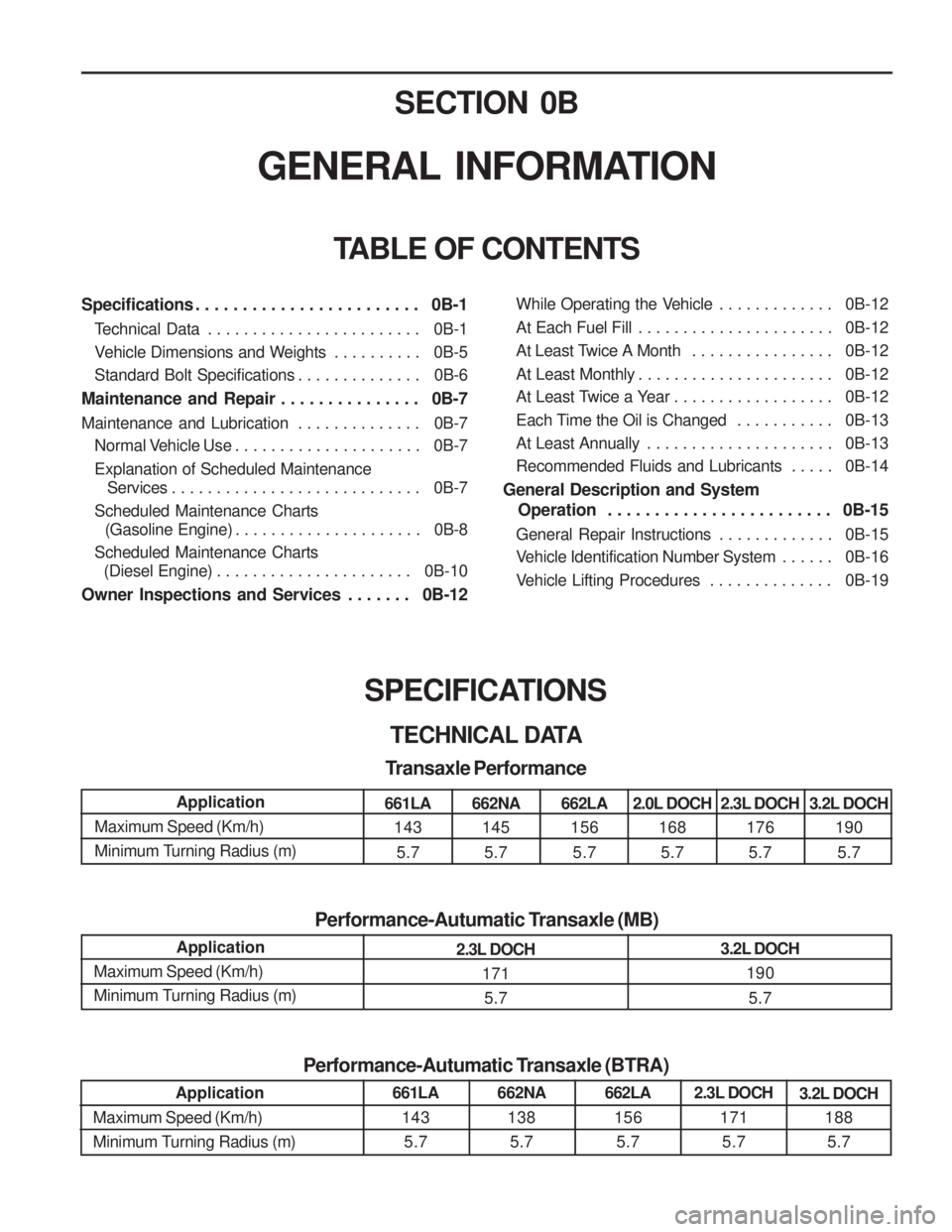
SECTION 0B
GENERAL INFORMATION
Specifications . . . . . . . . . . . . . . . . . . . . . . . . 0B-1Technical Data . . . . . . . . . . . . . . . . . . . . . . . . 0B-1
Vehicle Dimensions and Weights . . . . . . . . . . 0B-5
Standard Bolt Specifications . . . . . . . . . . . . . . 0B-6
Maintenance and Repair . . . . . . . . . . . . . . . 0B-7
Maintenance and Lubrication . . . . . . . . . . . . . . 0B-7 Normal Vehicle Use . . . . . . . . . . . . . . . . . . . . . 0B-7 Explanation of Scheduled Maintenance
Services . . . . . . . . . . . . . . . . . . . . . . . . . . . . 0B-7
Scheduled Maintenance Charts
(Gasoline Engine) . . . . . . . . . . . . . . . . . . . . . 0B-8 Scheduled Maintenance Charts
(Diesel Engine) . . . . . . . . . . . . . . . . . . . . . . 0B-10
Owner Inspections and Services . . . . . . . 0B-12 TABLE OF CONTENTS
While Operating the Vehicle . . . . . . . . . . . . . 0B-12
At Each Fuel Fill . . . . . . . . . . . . . . . . . . . . . . 0B-12
At Least Twice A Month . . . . . . . . . . . . . . . . 0B-12
At Least Monthly . . . . . . . . . . . . . . . . . . . . . . 0B-12
At Least Twice a Year . . . . . . . . . . . . . . . . . . 0B-12
Each Time the Oil is Changed . . . . . . . . . . . 0B-13
At Least Annually . . . . . . . . . . . . . . . . . . . . . 0B-13
Recommended Fluids and Lubricants . . . . . 0B-14
General Description and System
Operation . . . . . . . . . . . . . . . . . . . . . . . . 0B-15
General Repair Instructions . . . . . . . . . . . . . 0B-15
Vehicle Identification Number System . . . . . . 0B-16
Vehicle Lifting Procedures . . . . . . . . . . . . . . 0B-19
SPECIFICATIONS TECHNICAL DATA
Transaxle Performance
Application
Maximum Speed (Km/h)
Minimum Turning Radius (m)
661LA 143
5.7662NA 145
5.7 662LA
156
5.7 2.0L DOCH
168
5.7 2.3L DOCH
176
5.7 3.2L DOCH
190
5.7
Application
Maximum Speed (Km/h)
Minimum Turning Radius (m)
Performance-Autumatic Transaxle (MB)
2.3L DOCH171
5.7 3.2L DOCH
190
5.7
Application
Maximum Speed (Km/h)
Minimum Turning Radius (m)
Performance-Autumatic Transaxle (BTRA)
661LA1435.7 662NA
1385.7 662LA
1565.7 2.3L DOCH
1715.7 3.2L DOCH
1885.7
Page 8 of 1574
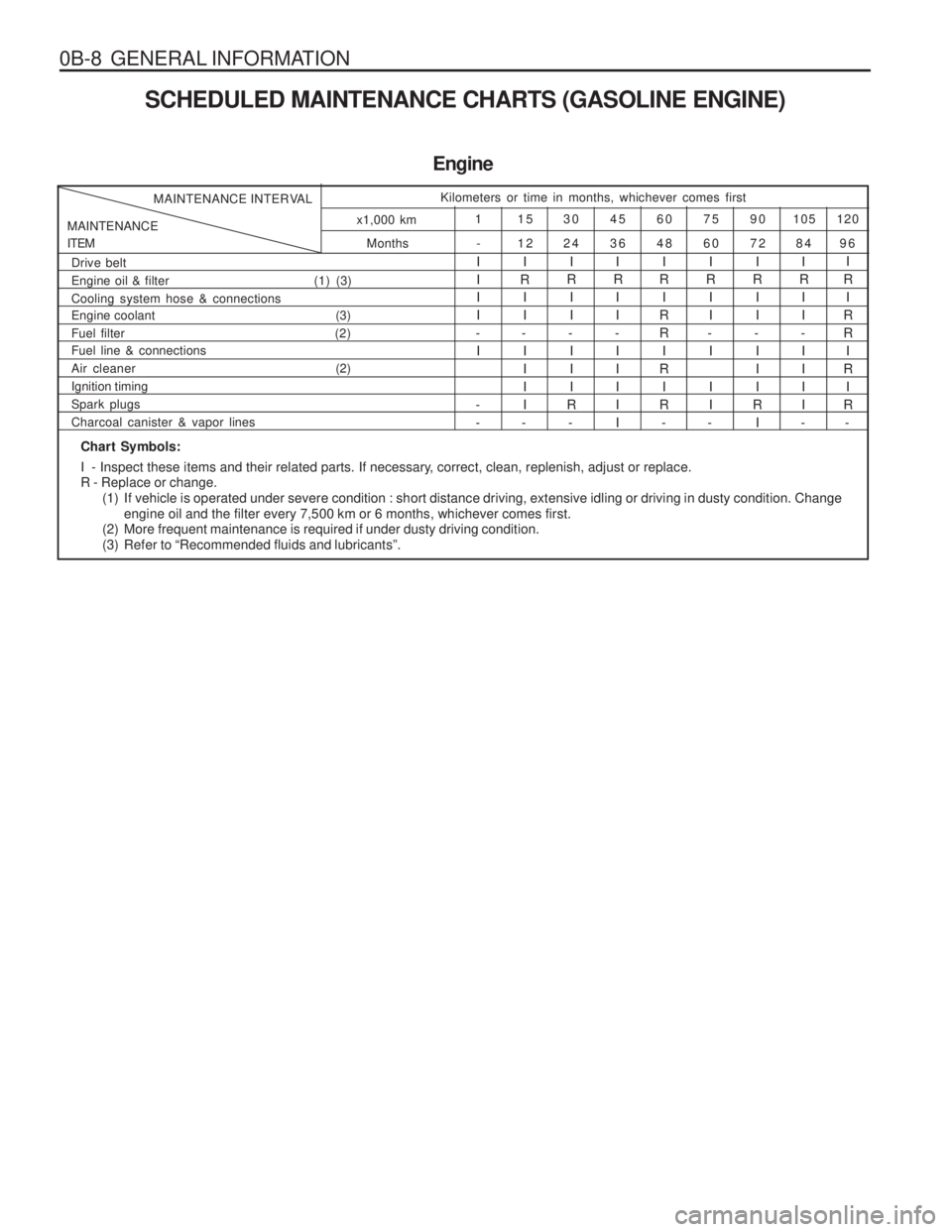
0B-8 GENERAL INFORMATIONSCHEDULED MAINTENANCE CHARTS (GASOLINE ENGINE)
Engine
Months
MAINTENANCE ITEM MAINTENANCE INTERVAL
Kilometers or time in months, whichever comes first
120
105
90
75
60
45
30
15
1
96
84
72
60
48
36
24
12
-
x1,000 km
Chart Symbols:
I - Inspect these items and their related parts. If necessary, correct, clean, replenish, adjust or replace. R - Replace or change.
(1) If vehicle is operated under severe condition : short distance driving, extensive idling or driving in dusty condition. Chan ge
engine oil and the filter every 7,500 km or 6 months, whichever comes first.
(2) More frequent maintenance is required if under dusty driving condition.
(3) Refer to “Recommended fluids and lubricants”.
Drive belt
Engine oil & filter (1) (3)Cooling system hose & connections
Engine coolant (3) Fuel filter
(2)
Fuel line & connections
Air cleaner (2)Ignition timingSpark plugsCharcoal canister & vapor lines
I III
- I
-- I
R II
- IIII
- I
R II
-
III
R - I
R II
- IIIII I
R I
RR I
R
I
R - I
R II
- I I I
- I
R II
- III
R I I
R II
- IIII
- I
R I
RR I
R I
R -
Page 9 of 1574
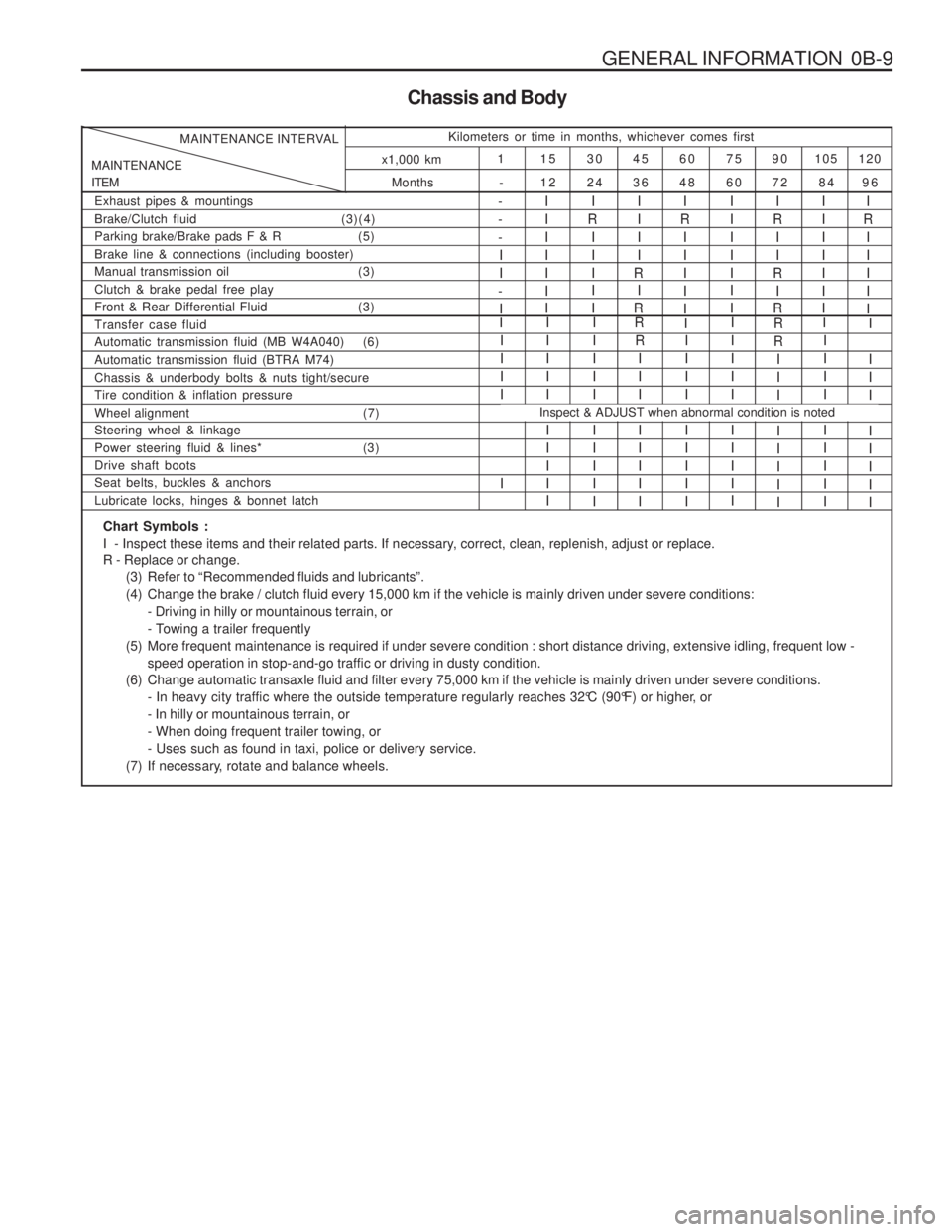
GENERAL INFORMATION 0B-9
Chassis and Body
Months
MAINTENANCE ITEM MAINTENANCE INTERVAL
Kilometers or time in months, whichever comes first
120
105
90
75
60
45
30
15
1
96
84
72
60
48
36
24
12
-
x1,000 km
Exhaust pipes & mountings Brake/Clutch fluid
(3)(4)
Parking brake/Brake pads F & R (5)Brake line & connections (including booster)
Manual transmission oil (3) Clutch & brake pedal free play
Front & Rear Differential Fluid (3)I
R
IIIII- --II
-
I IIIIII I
I
R I II I I IIII
R I
R IIIII I II
R
II
R I
R IIIIII II
R I IIII
Automatic transmission fluid (MB W4A040) (6) Automatic transmission fluid (BTRA M74)Chassis & underbody bolts & nuts tight/secure Tire condition & inflation pressure
Wheel alignment (7) Steering wheel & linkage
Power steering fluid & lines* (3)Drive shaft boots Seat belts, buckles & anchors Lubricate locks, hinges & bonnet latchIIII I I IIII I III I I IIII I IIII
R
III I IIII IIII I IIIIIIIII I III I
R R
III I IIII IIII I IIII
Transfer case fluidRII
I
Inspect & ADJUST when abnormal condition is noted
I
I II I IIII
Chart Symbols :
I - Inspect these items and their related parts. If necessary, correct, clean, replenish, adjust or replace.R - Replace or change.
(3) Refer to “Recommended fluids and lubricants”.
(4) Change the brake / clutch fluid every 15,000 km if the vehicle is mainly driven under severe conditions:- Driving in hilly or mountainous terrain, or
- Towing a trailer frequently
(5) More frequent maintenance is required if under severe condition : short distance driving, extensive idling, frequent low - speed operation in stop-and-go traffic or driving in dusty condition.
(6) Change automatic transaxle fluid and filter every 75,000 km if the vehicle is mainly driven under severe conditions. - In heavy city traffic where the outside temperature regularly reaches 32°C (90°F) or higher, or- In hilly or mountainous terrain, or- When doing frequent trailer towing, or- Uses such as found in taxi, police or delivery service.
(7) If necessary, rotate and balance wheels.
Page 10 of 1574
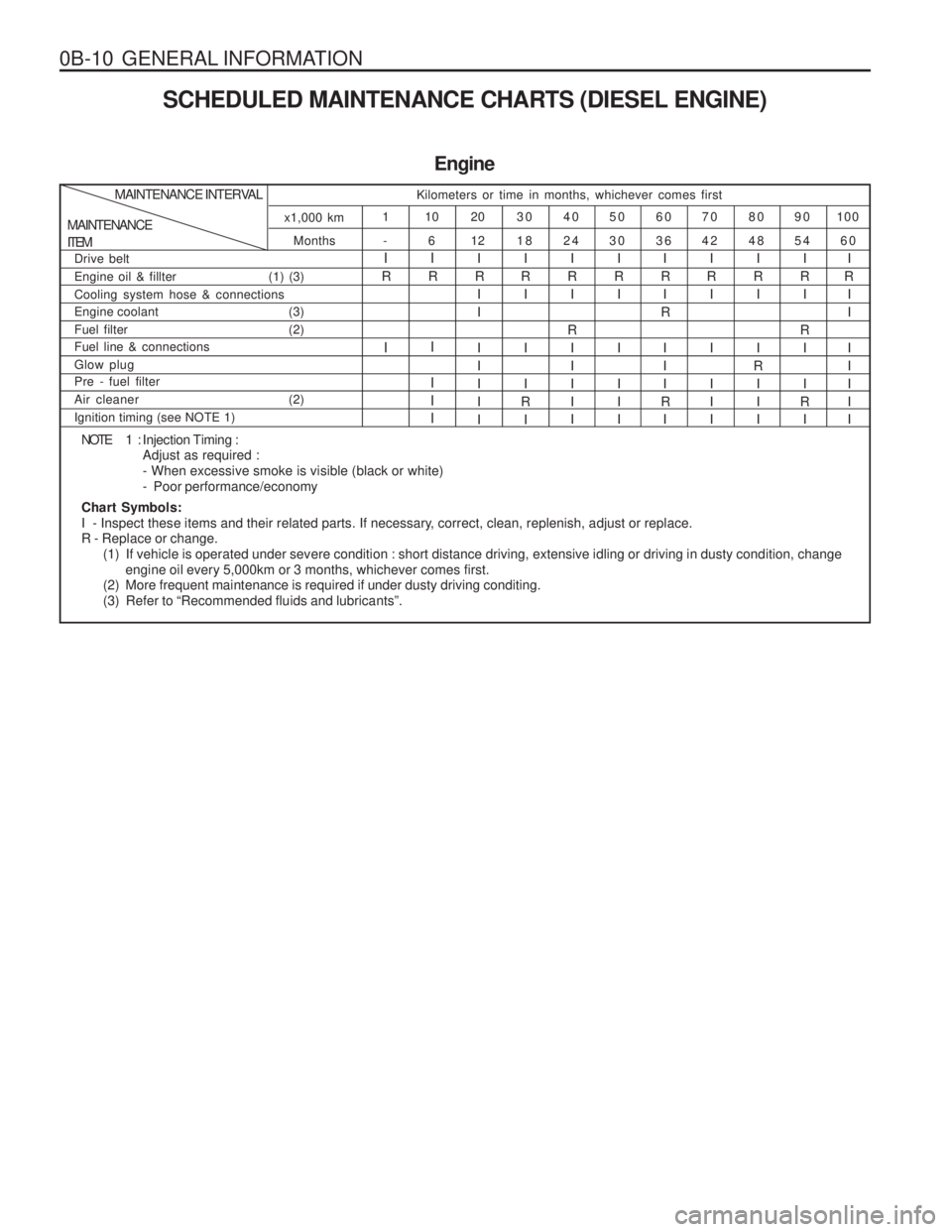
0B-10 GENERAL INFORMATIONSCHEDULED MAINTENANCE CHARTS (DIESEL ENGINE)
Engine
Months -
MAINTENANCE ITEM MAINTENANCE INTERVAL
Kilometers or time in months, whichever comes first
100
90
80
70
60
50
40
30
20
10
1
60
54
48
42
36
30
24
18
12
6
x1,000 km
NOTE 1 :
Injection Timing : Adjust as required :- When excessive smoke is visible (black or white)- Poor performance/economy
Chart Symbols:
I - Inspect these items and their related parts. If necessary, correct, clean, replenish, adjust or replace.R - Replace or change. (1) If vehicle is operated under severe condition : short distance driving, extensive idling or driving in dusty condition, chan ge
engine oil every 5,000km or 3 months, whichever comes first.
(2) More frequent maintenance is required if under dusty driving conditing.
(3) Refer to “Recommended fluids and lubricants”.
Drive belt Engine oil & fillter (1) (3)Cooling system hose & connections
Engine coolant (3)
Fuel filter (2) Fuel line & connections Glow plug Pre - fuel filter
Air cleaner (2)Ignition timing (see NOTE 1)
I
R
I
I
R
I I II
I
R I I I IIII I
R I I I
R I I
R I
R I IIII I
R I I I II I
R I
R
III
R I I
R I I I II I
R I I
R
I II I
R I
R I I
R I I
R I I I IIII
Page 11 of 1574
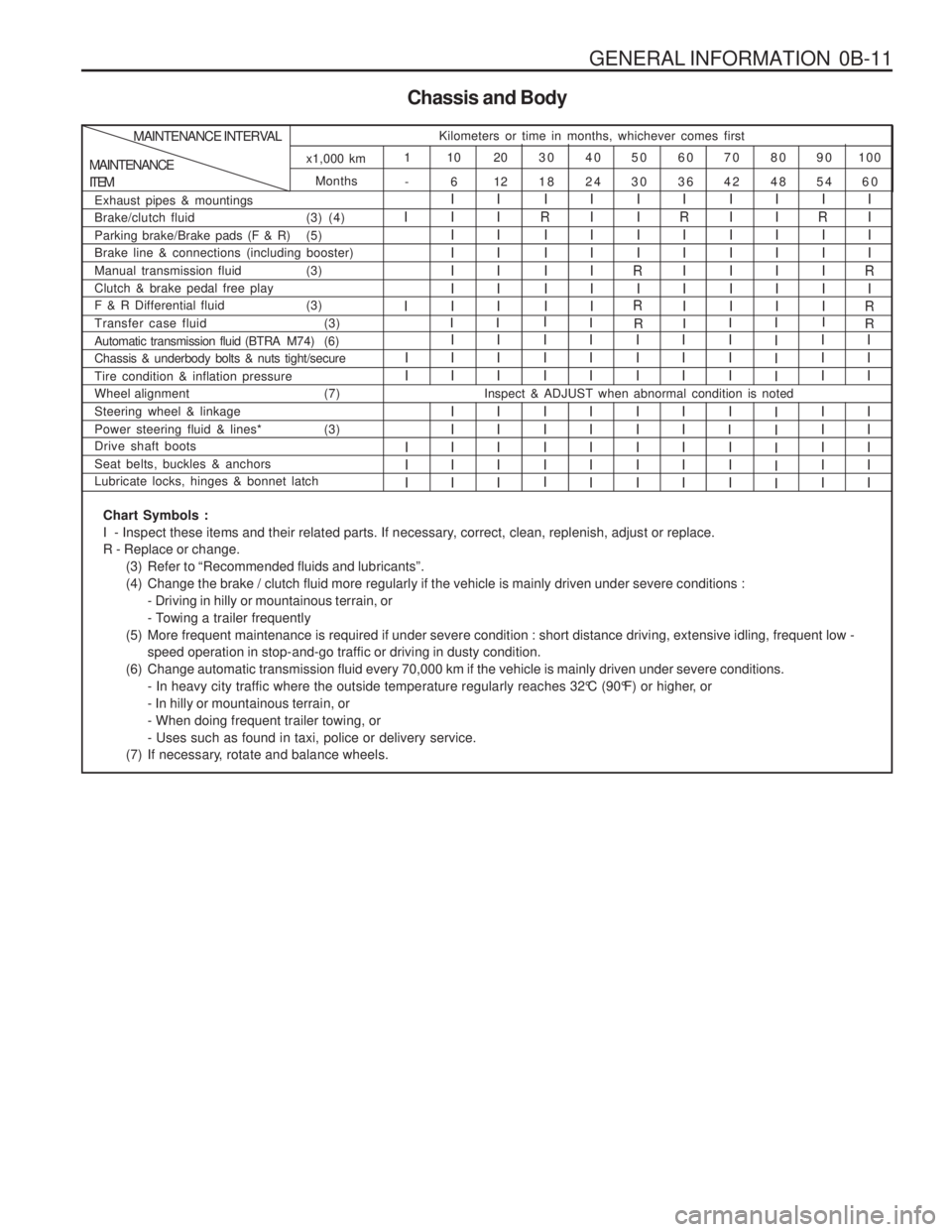
GENERAL INFORMATION 0B-11
Chassis and Body
Months -
MAINTENANCE ITEMMAINTENANCE INTERVAL
Kilometers or time in months, whichever comes first
100
90
80
70
60
50
40
30
20
10
1
60
54
48
42
36
30
24
18
12
6
x1,000 km
Exhaust pipes & mountings
Brake/clutch fluid (3) (4)
Parking brake/Brake pads (F & R) (5) Brake line & connections (including booster)
Manual transmission fluid (3)Clutch & brake pedal free play
F & R Differential fluid (3)
I I I IIIIIIIIIIIII I
R
IIIII IIIIIII IIII
R I
R I
R
IIIII IIIIIIIIIIIIII I
R
IIIII IIII
R I
R
Automatic transmission fluid (BTRA M74) (6) Chassis & underbody bolts & nuts tight/secure Tire condition & inflation pressure
Wheel alignment (7) Steering wheel & linkage
Power steering fluid & lines* (3) Drive shaft boots Seat belts, buckles & anchors Lubricate locks, hinges & bonnet latchI II I IIII III I IIII IIII I III I
I II I IIII III I IIIIIII I IIII III II II III I IIIIIII I IIII
Transfer case fluid (3)
RI R
I
I
I
I I I II IIII I IIII
Inspect & ADJUST when abnormal condition is noted
II I
Chart Symbols :
I - Inspect these items and their related parts. If necessary, correct, clean, replenish, adjust or replace.R - Replace or change.
(3) Refer to “Recommended fluids and lubricants”.
(4) Change the brake / clutch fluid more regularly if the vehicle is mainly driven under severe conditions :- Driving in hilly or mountainous terrain, or
- Towing a trailer frequently
(5) More frequent maintenance is required if under severe condition : short distance driving, extensive idling, frequent low - speed operation in stop-and-go traffic or driving in dusty condition.
(6) Change automatic transmission fluid every 70,000 km if the vehicle is mainly driven under severe conditions. - In heavy city traffic where the outside temperature regularly reaches 32°C (90°F) or higher, or- In hilly or mountainous terrain, or- When doing frequent trailer towing, or- Uses such as found in taxi, police or delivery service.
(7) If necessary, rotate and balance wheels.
Page 12 of 1574
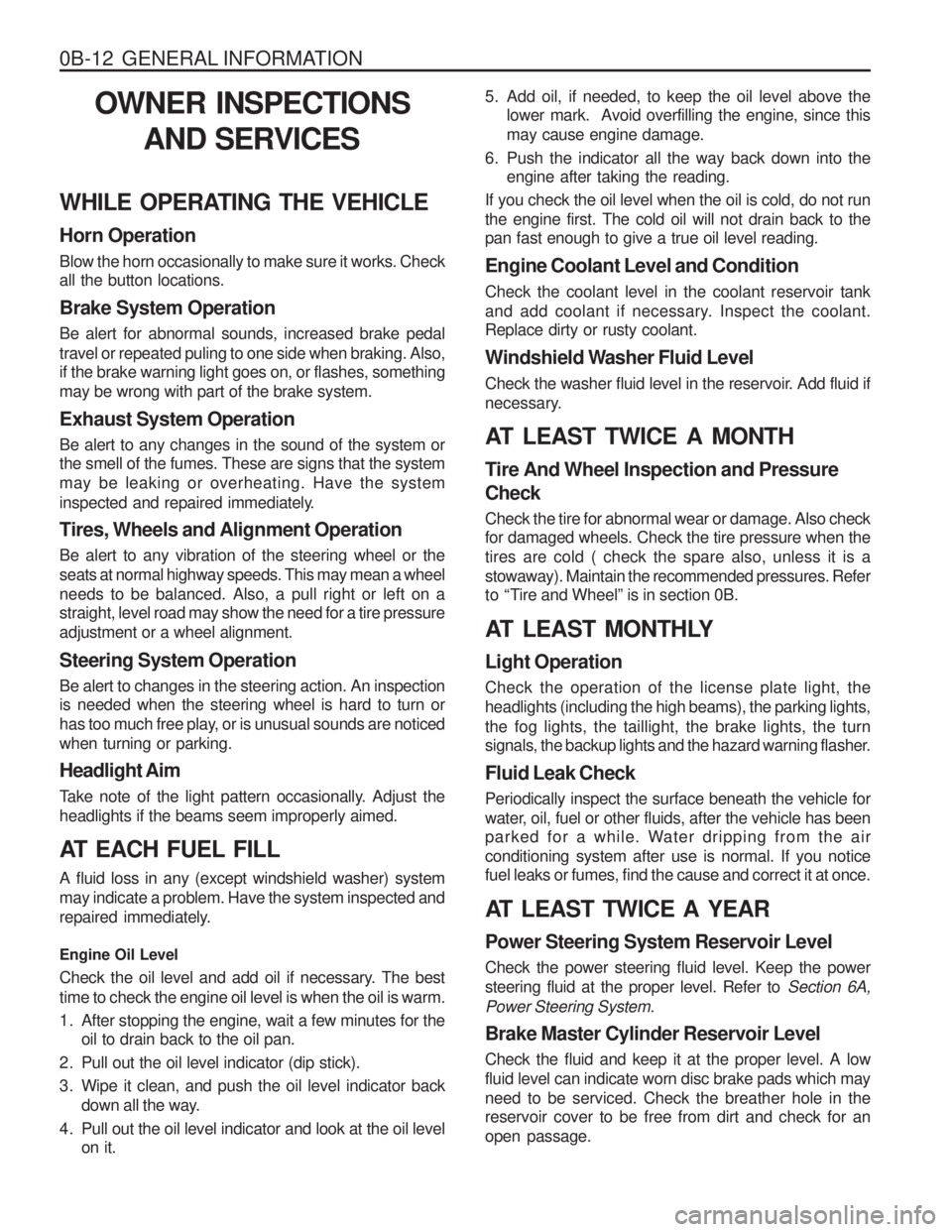
0B-12 GENERAL INFORMATIONOWNER INSPECTIONS AND SERVICES
WHILE OPERATING THE VEHICLE Horn Operation Blow the horn occasionally to make sure it works. Check all the button locations. Brake System Operation Be alert for abnormal sounds, increased brake pedal travel or repeated puling to one side when braking. Also, if the brake warning light goes on, or flashes, something may be wrong with part of the brake system. Exhaust System Operation Be alert to any changes in the sound of the system or the smell of the fumes. These are signs that the system may be leaking or overheating. Have the system
inspected and repaired immediately. Tires, Wheels and Alignment Operation Be alert to any vibration of the steering wheel or the seats at normal highway speeds. This may mean a wheelneeds to be balanced. Also, a pull right or left on a straight, level road may show the need for a tire pressure adjustment or a wheel alignment. Steering System Operation Be alert to changes in the steering action. An inspection is needed when the steering wheel is hard to turn or
has too much free play, or is unusual sounds are noticedwhen turning or parking. Headlight Aim
Take note of the light pattern occasionally. Adjust the headlights if the beams seem improperly aimed.
AT EACH FUEL FILL A fluid loss in any (except windshield washer) system may indicate a problem. Have the system inspected and
repaired immediately. Engine Oil Level
Check the oil level and add oil if necessary. The best time to check the engine oil level is when the oil is warm.
1. After stopping the engine, wait a few minutes for the oil to drain back to the oil pan.
2. Pull out the oil level indicator (dip stick).
3. Wipe it clean, and push the oil level indicator back down all the way.
4. Pull out the oil level indicator and look at the oil level on it. 5. Add oil, if needed, to keep the oil level above the
lower mark. Avoid overfilling the engine, since this may cause engine damage.
6. Push the indicator all the way back down into the engine after taking the reading.
If you check the oil level when the oil is cold, do not runthe engine first. The cold oil will not drain back to the pan fast enough to give a true oil level reading. Engine Coolant Level and Condition Check the coolant level in the coolant reservoir tank
and add coolant if necessary. Inspect the coolant. Replace dirty or rusty coolant.
Windshield Washer Fluid Level
Check the washer fluid level in the reservoir. Add fluid if
necessary.
AT LEAST TWICE A MONTH Tire And Wheel Inspection and Pressure Check Check the tire for abnormal wear or damage. Also check for damaged wheels. Check the tire pressure when the tires are cold ( check the spare also, unless it is astowaway). Maintain the recommended pressures. Refer
to “Tire and Wheel” is in section 0B.
AT LEAST MONTHLY Light Operation Check the operation of the license plate light, the headlights (including the high beams), the parking lights,the fog lights, the taillight, the brake lights, the turn
signals, the backup lights and the hazard warning flasher. Fluid Leak Check Periodically inspect the surface beneath the vehicle for
water, oil, fuel or other fluids, after the vehicle has been
parked for a while. Water dripping from the air conditioning system after use is normal. If you notice fuel leaks or fumes, find the cause and correct it at once.
AT LEAST TWICE A YEAR Power Steering System Reservoir Level Check the power steering fluid level. Keep the power steering fluid at the proper level. Refer to Section 6A,
Power Steering System. Brake Master Cylinder Reservoir Level Check the fluid and keep it at the proper level. A low fluid level can indicate worn disc brake pads which mayneed to be serviced. Check the breather hole in the reservoir cover to be free from dirt and check for an open passage.
Page 13 of 1574
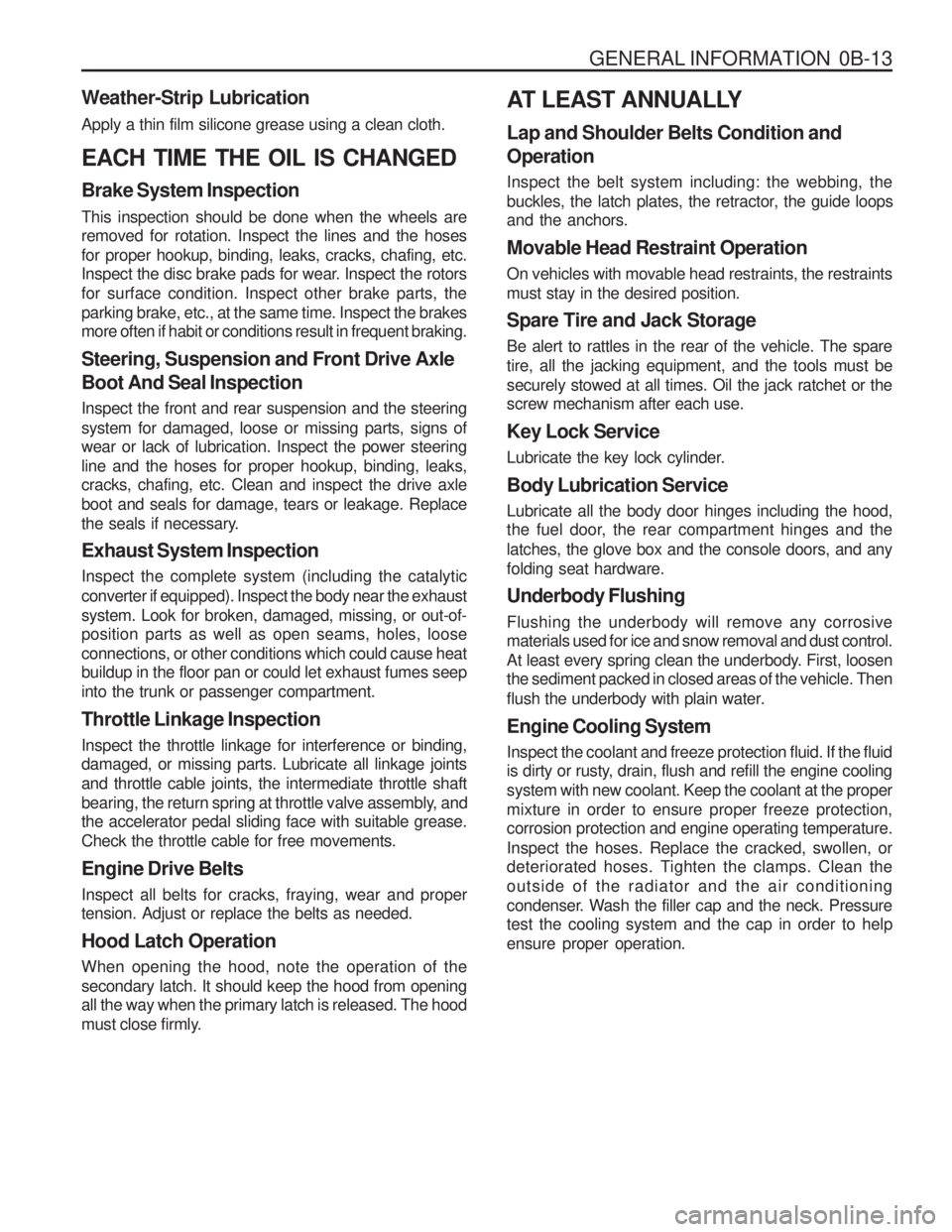
GENERAL INFORMATION 0B-13
Weather-Strip Lubrication Apply a thin film silicone grease using a clean cloth. EACH TIME THE OIL IS CHANGED Brake System Inspection This inspection should be done when the wheels are removed for rotation. Inspect the lines and the hoses for proper hookup, binding, leaks, cracks, chafing, etc.
Inspect the disc brake pads for wear. Inspect the rotors for surface condition. Inspect other brake parts, theparking brake, etc., at the same time. Inspect the brakes more often if habit or conditions result in frequent braking. Steering, Suspension and Front Drive Axle Boot And Seal Inspection Inspect the front and rear suspension and the steering system for damaged, loose or missing parts, signs of wear or lack of lubrication. Inspect the power steering line and the hoses for proper hookup, binding, leaks, cracks, chafing, etc. Clean and inspect the drive axle boot and seals for damage, tears or leakage. Replace
the seals if necessary. Exhaust System Inspection Inspect the complete system (including the catalytic converter if equipped). Inspect the body near the exhaustsystem. Look for broken, damaged, missing, or out-of- position parts as well as open seams, holes, loose connections, or other conditions which could cause heat buildup in the floor pan or could let exhaust fumes seep into the trunk or passenger compartment. Throttle Linkage Inspection Inspect the throttle linkage for interference or binding, damaged, or missing parts. Lubricate all linkage joints and throttle cable joints, the intermediate throttle shaft
bearing, the return spring at throttle valve assembly, and the accelerator pedal sliding face with suitable grease. Check the throttle cable for free movements. Engine Drive Belts Inspect all belts for cracks, fraying, wear and proper tension. Adjust or replace the belts as needed. Hood Latch Operation When opening the hood, note the operation of the secondary latch. It should keep the hood from opening all the way when the primary latch is released. The hood
must close firmly. AT LEAST ANNUALLY Lap and Shoulder Belts Condition and Operation Inspect the belt system including: the webbing, the
buckles, the latch plates, the retractor, the guide loops and the anchors. Movable Head Restraint Operation On vehicles with movable head restraints, the restraints must stay in the desired position. Spare Tire and Jack Storage Be alert to rattles in the rear of the vehicle. The spare tire, all the jacking equipment, and the tools must besecurely stowed at all times. Oil the jack ratchet or the screw mechanism after each use. Key Lock Service
Lubricate the key lock cylinder. Body Lubrication Service Lubricate all the body door hinges including the hood,
the fuel door, the rear compartment hinges and the latches, the glove box and the console doors, and anyfolding seat hardware. Underbody Flushing Flushing the underbody will remove any corrosive materials used for ice and snow removal and dust control.
At least every spring clean the underbody. First, loosen the sediment packed in closed areas of the vehicle. Then
flush the underbody with plain water. Engine Cooling System Inspect the coolant and freeze protection fluid. If the fluid
is dirty or rusty, drain, flush and refill the engine cooling system with new coolant. Keep the coolant at the propermixture in order to ensure proper freeze protection, corrosion protection and engine operating temperature. Inspect the hoses. Replace the cracked, swollen, or
deteriorated hoses. Tighten the clamps. Clean the outside of the radiator and the air conditioning
condenser. Wash the filler cap and the neck. Pressure test the cooling system and the cap in order to help ensure proper operation.
Page 555 of 1574

M162 ENGINE CONTROLS 1F1-23
Failurecode ItemChecking method
Te s t stepRequirementSpecified
value Possible cause
106 11 The value will
be changed in 1.2 - 1.7 V
- Voltage
(alternating)
0.9 - 1.6 �
71 11
71 72
Engine:in cranking
� 7.1
Ignition:ON
- Remove the connector from the Camshaft positionsensor betweenNo.1 terminal andNo.3 terminal.
13
11 -14 V
Camshaft
positionsensor(E23 only)- Power supply
Cable
OVPR
Ignition
coil(T1/1) - primary coil voltage(No.2 and 5 cylinder)
Engine:in cranking
(starter operating)- Measuring range: 400 V
- Time range: 100 %(using engine tester)
Ignition:OFF 200 - 350 VCamshaft position
sensor
64, � 8.0
� 8.1
� 8.1
Connecting
resistance of ignition coilbetween T1/1 and T1/2
Cable
Ignition coil T1/1
Ignition coil T1/2
72 11
Ignition
coil(T1/2) - primary coil voltage(No.3 and 4cylinder)
Engine:in cranking
(starter operating)- Measuring range: 400 V
- Time range: 100 %(using engine tester) 200 - 350 V
65, � 9.0
� 9.1
0.9 - 1.6 �
72 71
Ignition:OFF� 9.1
Connecting
resistance of ignition coilbetween T1/2 and T1/1
Cable
Ignition coil T1/1
Ignition coil T1/2
The
resistance of
ignition coil at 20°C is
approached 0.6�
The
resistance of
ignition coil at 20°C is
approached 0.6�
Page 580 of 1574

1F1-48 M162 ENGINE CONTROLSA . Valves Closed
B. Valves Opened
The pressure difference between the fuel pressure and the intake manifold is about 3.8 bars during the full load.
Consequently, the fuel pressure in the fuel distributor changes by the intake manifold's negative pressure, and the injector'sfuel pressure gets reduced independently to the throttle valve'sposition. Thus, the fuel injection volume can only be determined according to the injector's injecting duration. 2. Fuel return line
3. Valve
5. Diaphragm
6. Compression Spring
8. Fuel Chamber
9. Spring Chamber
1. Fuel Pressure Regulator
2. Intake Manifold
3. Fuel Return(to fuel tank)
4. Fuel Supply(form fuel pump)
5. Fuel Pressure(approx. 3.8 bars)
6. Intake Manifold Negative Pressure(0 bar)
Function of the Fuel Pressure Regulator The fuel pressure regulator maintains the fuel pressure in the fuel line with the pressure of 3.2 bars to 3.8 bars according tothe intake manifold pressure. This operating pressure cannotbe changed, and the fuel injection volume will be only determined by the injection time. Over supplied fuel returns to the fuel tank through the return line.
Page 820 of 1574
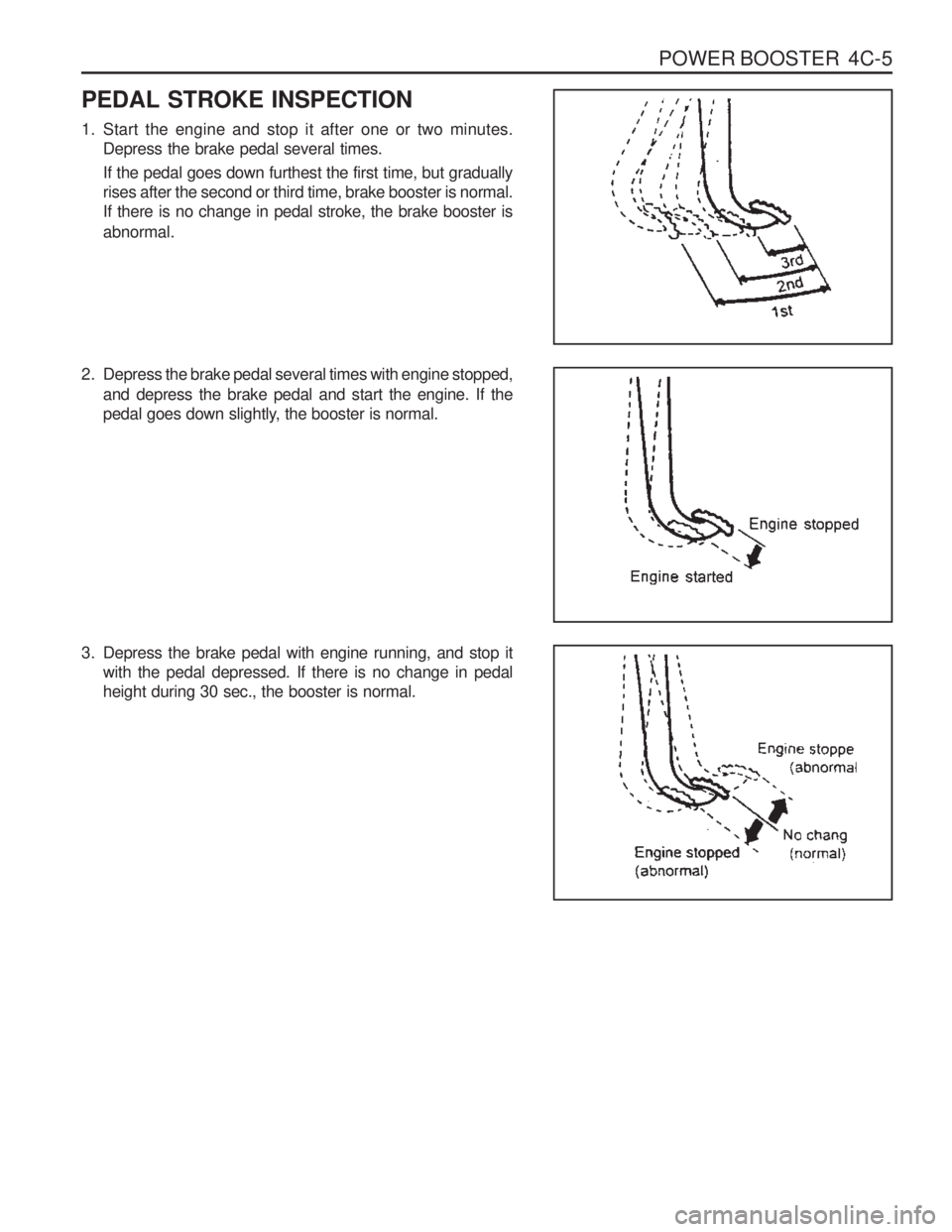
POWER BOOSTER 4C-5
PEDAL STROKE INSPECTION
1. Start the engine and stop it after one or two minutes.Depress the brake pedal several times. If the pedal goes down furthest the first time, but gradually rises after the second or third time, brake booster is normal.If there is no change in pedal stroke, the brake booster is abnormal.
2. Depress the brake pedal several times with engine stopped, and depress the brake pedal and start the engine. If the
pedal goes down slightly, the booster is normal.
3. Depress the brake pedal with engine running, and stop it with the pedal depressed. If there is no change in pedalheight during 30 sec., the booster is normal.